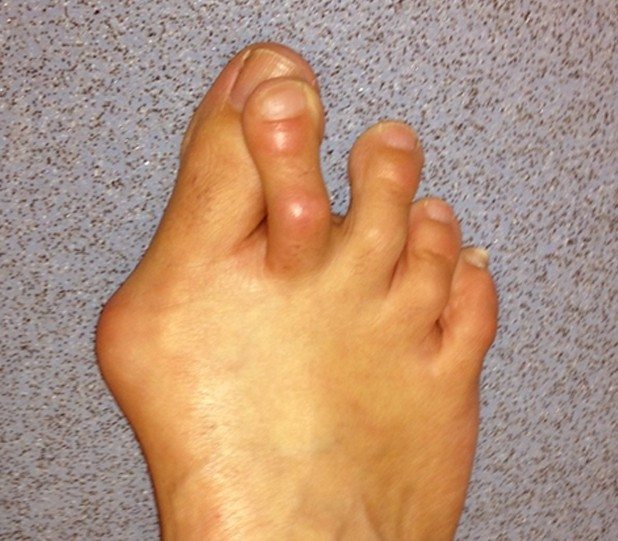Overlapping and Underlapping Toes
An overlapping toe condition occurs when one of your toes, usually the big toe or pinky toe, extends over the adjacent toe. A similar condition, called an underlapping toe, develops when your toe extends under the adjacent toe.
Any problems that cause pain or discomfort in the toes should be given prompt attention. Ignoring the symptoms can aggravate the condition, and lead to a breakdown of tissue or even infection. Conservative treatment (non-surgical treatment) of overlapping toes begins with accommodating the disorder. Shoes with a high, broad toe box (toe area) are recommended for people suffering from overlapping toes. Forefoot supports such as gel toe straighteners, gel toe caps and toe combs are often recommended to keep overlapping toes apart. These effective devices are designed to reduce friction to help relieve the discomfort.
Deformities of the toes are common in the children. Generally, they are inherited with both or one of the parents having the same or similar condition. Many of these deformities are present at birth and can become worse with time. Rarely do children outgrow these deformities although rare instances of spontaneous resolution of some deformities have been reported.
Malformation of the toes in infancy and early childhood are rarely symptomatic. The complaints of parents are more cosmetic in nature. However, as the child matures these deformities progress from a flexible deformity to a rigid deformity and become progressively symptomatic. Many of these deformities are unresponsive to conservative treatment. Common digital deformities are underlapping toes, overlapping toes, flexed or contracted toes and mallet toes. Quite often a prolonged course of digital splitting and exercises is implemented. As the deformity becomes more rigid surgery will most likely be required if correction of the deformity is the goal.
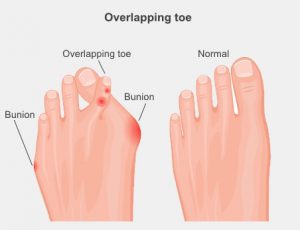
What Causes Overlapping Toes
The exact cause of overlapping toes is still unclear, but a number of factors are considered responsible for overlapping toes.
- Genetics, as the condition runs in families.
- Position of the fetus during development inside the womb may affect the position of toes
- High arches or flat feet (fallen arches) in children alter the normal biomechanics of the foot, leading to overlapped toes, mostly the fifth toe.
- Hammer toes (toes bent in the form of a hammer) can also lead to overlapping of toes.
- Bunions cause the big toe to bend outwards towards the smaller toes, cramping their space and causing them to overlap. Usually the second toe overlaps.
- Ill-fitting shoes: high heels with narrow toe sections cause cramping of the toes. Prolonged cramping may lead to overlapping of the toes.
- Long second toe
- Injuries, as dislocated joints may also be a reason for the overlapping of the toes.
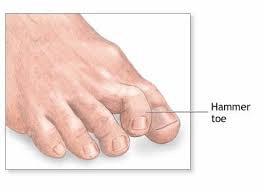
What Problems Do Overlapping Toes Cause?
Pain & Irritation
The biggest symptom of an overlapping toe is the pain that often occurs from the condition. The pain is also most often accompanied by inflammation of the toes and irritation caused by the toes rubbing together or rubbing against the side of the surrounding shoe.
Corns
If you have overlapping toes, you can also develop corns on your feet. The corns develop due to friction between the toes, mostly on the knuckle area of the toe or the outside of the outer toes. In extreme cases these corns can lead to underlying wounds and ulceration especially when combined with diseases such as diabetes and peripheral vascular disease.
Footwear Fitting Issues
Overlapping toes can distort the natural shape and size of your foot which can subsequently make finding and fitting into normal footwear difficult. In severe cases custom made or extra depth footwear is necessary.
Unnatural Gait
The pain caused by overlapping toes may cause you to compensate your gait. Naturally, you’ll walk to avoid the pain which over time can compromise the way you walk. This can later lead to other problems.
Treatment for Overlapping Toes?
Once you are diagnosed with an overlapping toe, you need to act quickly to correct the problem before it gets worse. To correct an overlapping toe condition, you have a few options to choose from, including surgery, changing to looser fitting shoes, and using corrective orthotics, such as spacers and toe loops.
Toe Separators and Spacers
Toe separators and spacers help separate your toes and keep them in the proper alignment. You can find a wide selection of toe separators and spacers online, or your Podiatrist can order a custom orthotic designed to help with toe separation.
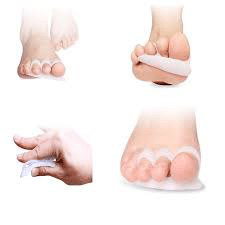
Toe Loops and Bandages
Toe loops and bandages basically secure your toe to the adjacent toe, holding it in place. The idea behind a loop or bandage is to give extra support to the overlapping toe so it remains properly aligned.
While not as effective as a spacer or separator, a bandage or loop is not as intrusive, allowing you to walk with them in place if necessary.
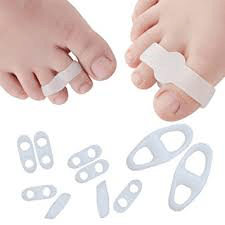
Corn Protectors
Corns occur on your feet due to constant friction and pressure, usually on the pad or top of your foot, as well as on the outside of the fifth toe. To protect a corn after it has begun to form, and to help it heal, you can use corn protectors.
Corn protectors surround the corn with a protective covering to keep the corn from rubbing, allowing it to heal properly.
Another option is to remove the harder dead skin patch of the corn with a pumice stone and then apply lotion to moisturize the remaining dead skin cells in an effort to soften them.
Ultimately, you need to change the condition causing the formation of the corn, including changing your footwear to shoes that do not rub the area.

Hammertoe Crest Pad
Hammertoe crest pads provide another solution to help relieve an overlapping toe condition. The pads do this by relieving the pressure that causes a hammertoe condition.
Made of either gel or foam, the crest pad rests underneath the bottom of your toes directly at the front of your foot.
Undergoing Overlapping Toe Surgery
One extreme treatment option is to get surgery to correct an overlapping toe problem. Most Podiatrists like to avoid surgery and seek other treatment options before resorting to it, if possible. But sometimes surgery is the only way to correct an overlapping toe problem.
At the Foot and Ankle Clinic our highly qualified team of Podiatrists are all members of the Australian Podiatry Association and offer a combined 50 years’ experience. They are trained to diagnose and effectively treat overlapping or underlapping toes via a range of treatments.
Put your feet in our hands! See us today in Chadstone, Moe, Sale, Traralgon, Warragul & Online Store and Retail Enquiries. NO REFERRAL NEEDED!.

